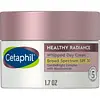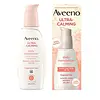What's inside
What's inside
 Key Ingredients
Key Ingredients

 Benefits
Benefits

 Concerns
Concerns

 Ingredients Side-by-side
Ingredients Side-by-side

Water
Skin ConditioningC12-15 Alkyl Benzoate
AntimicrobialButylene Glycol
HumectantIsododecane
EmollientSorbitol
HumectantSilica
AbrasiveStyrene/Acrylates Copolymer
Cetearyl Alcohol
EmollientNiacinamide
SmoothingGlycerin
HumectantPhenoxyethanol
PreservativeDimethicone
EmollientGlyceryl Stearate
EmollientPEG-100 Stearate
Ceteareth-20
CleansingPhenylethyl Resorcinol
AntioxidantCarbomer
Emulsion StabilisingEthylhexyl Acrylate
Sorbitan Stearate
EmulsifyingSynthetic Fluorphlogopite
Ethylhexylglycerin
Skin ConditioningTitanium Dioxide
Cosmetic ColorantDisodium EDTA
Sodium Hydroxide
BufferingTin Oxide
AbrasiveWater, C12-15 Alkyl Benzoate, Butylene Glycol, Isododecane, Sorbitol, Silica, Styrene/Acrylates Copolymer, Cetearyl Alcohol, Niacinamide, Glycerin, Phenoxyethanol, Dimethicone, Glyceryl Stearate, PEG-100 Stearate, Ceteareth-20, Phenylethyl Resorcinol, Carbomer, Ethylhexyl Acrylate, Sorbitan Stearate, Synthetic Fluorphlogopite, Ethylhexylglycerin, Titanium Dioxide, Disodium EDTA, Sodium Hydroxide, Tin Oxide
Titanium Dioxide 4.3%
Cosmetic ColorantZinc Oxide 3%
Cosmetic ColorantWater
Skin ConditioningC12-15 Alkyl Benzoate
AntimicrobialCyclopentasiloxane
EmollientGlycerin
HumectantStyrene/Acrylates Copolymer
Isopropyl Myristate
EmollientCetyl Dimethicone
EmollientOctyldodecyl Neopentanoate
EmollientGlyceryl Behenate
EmollientPEG-100 Stearate
Glyceryl Stearate
EmollientBenzyl Alcohol
PerfumingAluminum Stearate
Cosmetic ColorantArachidyl Alcohol
EmollientEthylhexylglycerin
Skin ConditioningPolyhydroxystearic Acid
EmulsifyingCaprylyl Glycol
EmollientBehenyl Alcohol
EmollientAlumina
AbrasiveHydroxyethyl Acrylate/Sodium Acryloyldimethyl Taurate Copolymer
Emulsion StabilisingXanthan Gum
EmulsifyingCitric Acid
BufferingMethyldihydrojasmonate
MaskingSqualane
EmollientArachidyl Glucoside
EmulsifyingDimethicone
EmollientChlorphenesin
AntimicrobialTriethoxycaprylylsilane
Dipropylene Glycol Dibenzoate
EmollientChrysanthemum Parthenium Flower/Leaf/Stem Juice
AntioxidantPPG-15 Stearyl Ether Benzoate
EmollientAcrylates/Dimethicone Copolymer
Skin ConditioningSodium Citrate
BufferingPolysorbate 60
EmulsifyingAlpha-Isomethyl Ionone
PerfumingMethyl Ionones
MaskingCeramide NP
Skin ConditioningAvena Sativa Kernel Extract
AbrasiveTitanium Dioxide 4.3%, Zinc Oxide 3%, Water, C12-15 Alkyl Benzoate, Cyclopentasiloxane, Glycerin, Styrene/Acrylates Copolymer, Isopropyl Myristate, Cetyl Dimethicone, Octyldodecyl Neopentanoate, Glyceryl Behenate, PEG-100 Stearate, Glyceryl Stearate, Benzyl Alcohol, Aluminum Stearate, Arachidyl Alcohol, Ethylhexylglycerin, Polyhydroxystearic Acid, Caprylyl Glycol, Behenyl Alcohol, Alumina, Hydroxyethyl Acrylate/Sodium Acryloyldimethyl Taurate Copolymer, Xanthan Gum, Citric Acid, Methyldihydrojasmonate, Squalane, Arachidyl Glucoside, Dimethicone, Chlorphenesin, Triethoxycaprylylsilane, Dipropylene Glycol Dibenzoate, Chrysanthemum Parthenium Flower/Leaf/Stem Juice, PPG-15 Stearyl Ether Benzoate, Acrylates/Dimethicone Copolymer, Sodium Citrate, Polysorbate 60, Alpha-Isomethyl Ionone, Methyl Ionones, Ceramide NP, Avena Sativa Kernel Extract
Ingredients Explained
These ingredients are found in both products.
Ingredients higher up in an ingredient list are typically present in a larger amount.
C12-15 Alkyl Benzoate is made up of Benzoic Acid and long chain alcohols. It has a low molecular weight.
C12-15 Alkyl Benzoate is an emollient and texture enhancer. Due to its solubility, it is often used in sunscreens to help evenly distribute active ingredients.
As an emollient, C12-15 Alkyl Benzoate helps soften and hydrate your skin. Emollients create a film on your skin that traps moisture within.
This ingredient has been reported to cause eye irritation.
Learn more about C12-15 Alkyl BenzoateDimethicone is a type of synthetic silicone created from natural materials such as quartz.
What it does:
Dimethicone comes in different viscosities:
Depending on the viscosity, dimethicone has different properties.
Ingredients lists don't always show which type is used, so we recommend reaching out to the brand if you have questions about the viscosity.
This ingredient is unlikely to cause irritation because it does not get absorbed into skin. However, people with silicone allergies should be careful about using this ingredient.
Note: Dimethicone may contribute to pilling. This is because it is not oil or water soluble, so pilling may occur when layered with products. When mixed with heavy oils in a formula, the outcome is also quite greasy.
Learn more about DimethiconeEthylhexylglycerin (we can't pronounce this either) is commonly used as a preservative and skin softener. It is derived from glyceryl.
You might see Ethylhexylglycerin often paired with other preservatives such as phenoxyethanol. Ethylhexylglycerin has been found to increase the effectiveness of these other preservatives.
Glycerin is already naturally found in your skin. It helps moisturize and protect your skin.
A study from 2016 found glycerin to be more effective as a humectant than AHAs and hyaluronic acid.
As a humectant, it helps the skin stay hydrated by pulling moisture to your skin. The low molecular weight of glycerin allows it to pull moisture into the deeper layers of your skin.
Hydrated skin improves your skin barrier; Your skin barrier helps protect against irritants and bacteria.
Glycerin has also been found to have antimicrobial and antiviral properties. Due to these properties, glycerin is often used in wound and burn treatments.
In cosmetics, glycerin is usually derived from plants such as soybean or palm. However, it can also be sourced from animals, such as tallow or animal fat.
This ingredient is organic, colorless, odorless, and non-toxic.
Glycerin is the name for this ingredient in American English. British English uses Glycerol/Glycerine.
Learn more about GlycerinGlyceryl Stearate is a mix of glycerin and stearic acid.
It is used to stabilize the mixing of water and oil ingredients. By preventing these ingredients from separating, it can help elongate shelf life. It can also help thicken the product's texture.
As an emollient, it helps soften skin and supports barrier-replenishing ingredients.
In cosmetics, Glyceryl Stearate is often made from vegetable oils or synthetically produced.
This ingredient may not be fungal-acne safe
Fun fact: The human body also creates Glyceryl Stearate naturally.
Learn more about Glyceryl StearatePeg-100 Stearate is an emollient and emulsifier. As an emollient, it helps keep skin soft by trapping moisture in. On the other hand, emulsifiers help prevent oil and water from separating in a product.
PEGS are a hydrophilic polyether compound . There are 100 ethylene oxide monomers in Peg-100 Stearate. Peg-100 Stearate is polyethylene glycol ester of stearic acid.
We don't have a description for Styrene/Acrylates Copolymer yet.
Titanium dioxide is a mineral UV filter widely used in sunscreens and cosmetics.
It is one of only two UV filters officially classified as “mineral” by regulatory agencies, the other being zinc oxide.
Titanium dioxide provides broad-spectrum protection mostly in the UVB and UVAII range, with some protection in the UVAI range.
While its UVA protection isn’t as strong as zinc oxide’s, the difference is minor.
A common myth is that mineral UV filters reflect UV light. However, modern research shows titanium dioxide absorbs UV radiation like chemical filters (~95% absorption & 5% reflection).
Thanks to its non-irritating nature, titanium dioxide is suitable for sensitive, acne-prone, or redness-prone skin. It is unlikely to cause "eye sting" like other sunscreen ingredients.
A major drawback of this ingredient is its white cast and thick texture. This is why mineral sunscreens often leave a white cast and are less cosmetically elegant than chemical/hybrid sunscreens.
To improve white cast and spreadability, micronized or nano-sized titanium dioxide is often used.
There are ongoing concerns surrounding nano-titanium oxide's impact on marine ecosystems.
There is no conclusive evidence that any form of titanium oxide (or any other sunscreen ingredients) will cause harm to marine ecosystems or coral reefs. The science is still developing but many consumers are keeping a close eye on this issue.
Please note, many destinations have reef-safety sunscreen rules. For instance, the U.S. Virgin Islands advises all visitors to use non-nano mineral sunscreens.
Nano mineral sunscreens once raised safety concerns about absorption into skin.
Extensive research has shown that they do not penetrate healthy or damaged skin; they remain safely on the surface and the top layer of dead skin (stratum corneum).
You'll likely find titanium dioxide bundled with alumina, silica, or dimethicone. These ingredients help make titanium dioxide highly photostable; this prevents it from interacting with other formula components under UV light.
Learn more about Titanium DioxideWater. It's the most common cosmetic ingredient of all. You'll usually see it at the top of ingredient lists, meaning that it makes up the largest part of the product.
So why is it so popular? Water most often acts as a solvent - this means that it helps dissolve other ingredients into the formulation.
You'll also recognize water as that liquid we all need to stay alive. If you see this, drink a glass of water. Stay hydrated!
Learn more about Water